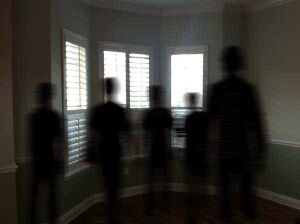Shadow people

Shadow people are a common hallucination for humans to have. They usually appear as a result of sleep deprivation, psychoactive substancess, or hypnagogic states. During this experience, the subject perceives a patch of shadow in their peripheral vision or focused visual field to be a living, autonomous figure. This figure can be either animal-like or humanoid in appearance. This hallucination is often accompanied with a feeling of intense paranoia and anxiety.
Visual component
The visual external hallucinations usually appear as initial fleeting images out of the corner of the eyes, in the peripheral vision. As time progresses, however, the hallucinations may appear in full view and one will be able to look directly at them, even being able to look away and look back at the entity without a change in the hallucination. This progression is the same whether you are experiencing shadow people from sleep deprivation or from stimulant psychosis.
The bodies of the shadow people are usually a type of blackness that has a sense of depth with few facial or bodily features. The blackness of the body seems almost opaque - it's like looking into a black hole in anthropomorphic form. They sometimes appear to have faces and are able to move or change shape.
Multiple shadow people can occupy the field of vision at once, acting autonomously from one another. This can occur in the peripheral vision or in the focused field of vision.
Auditory component
Occasionally, the visual representation of a shadow person can have an accompanying "voice", despite the common lack of a mouth structure.
When communicated with through spoken word, the level of coherency in which these entities can communicate with is highly variable but can be broken down into four distinct levels. These are listed below as:
- Silence - This level can be defined as a complete unresponsiveness from the side of the entity and an incapability of speech despite their obvious presence within the hallucination.
- Partially defined incoherent speech - This level can be defined as audible linguistic conversational responses and noises which sound like words but do not contain any real content or meaning beyond a vague sense of emotional intent.
- Fully defined incoherent speech - This level can be defined as audible linguistic conversational responses and noises which contain fully defined and understandable words but often lack grammatical structure or an overall sense of general coherency.
- Partially defined coherent speech - This level can be defined as audible linguistic conversational responses and noises which contain fully defined and understandable words with a partially defined grammatical structure and general coherency which conveys its point on a level which may not always be fully understandable but is still capable of conveying a general point.
- Fully defined coherent speech - This level can be defined as audible linguistic conversational responses which contain understandable words and a fully defined grammatical sentence structures or an overall sense of general coherency which conveys its point on a level that is on par with that of own intellect.
Tactile component
Rarely, shadow people can cause tactile hallucinations that are indistinguishable from a real human touch. These physical sensations can be moderate in temperature, but they can also be cold to the touch. Pulling of clothing, hair, or the skin has been reported by some individuals.
Gustatory component
This component is more rare than the other components of a shadow person experience and may manifest itself as a wide range of gustatory hallucinations.
Accompanying mental states
These hallucinations are often perceived as being malicious due to intense paranoia and anxiety that often occur simultaneously. Tactile hallucinations, feelings of convincing physical sensations that are not actually occurring within reality, may occur. Auditory hallucinations may also manifest themselves, causing one to perceive that the shadow people are talking to them and furthering the sense of panic.
Image examples
Psychoactive substances
Compounds within our psychoactive substance index which may cause this effect include: